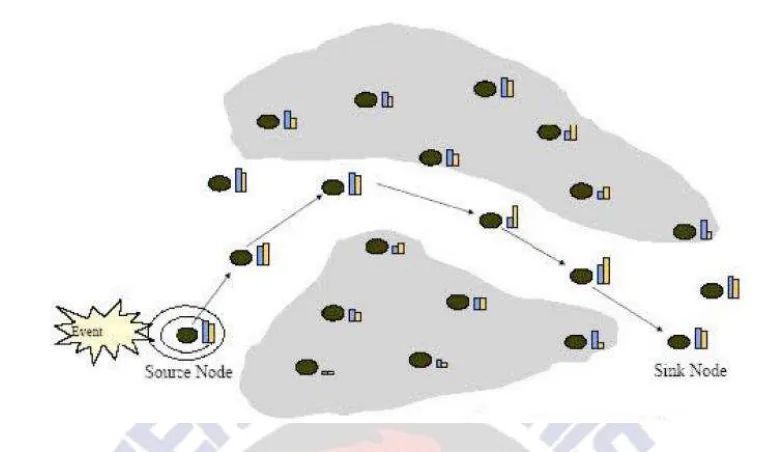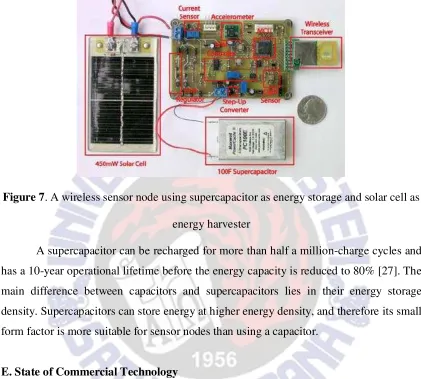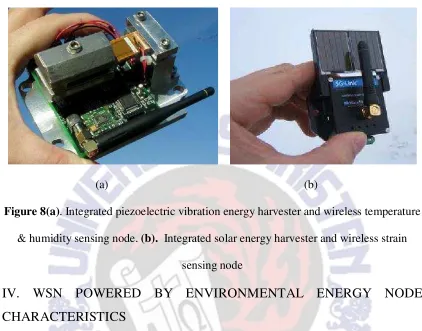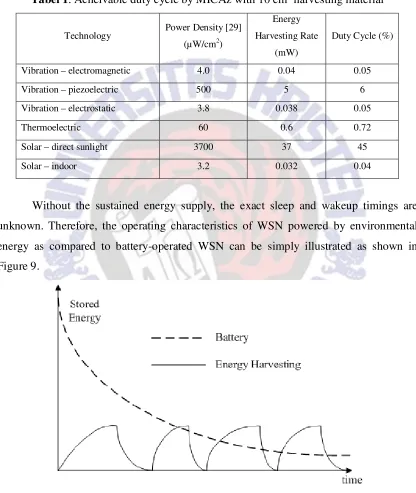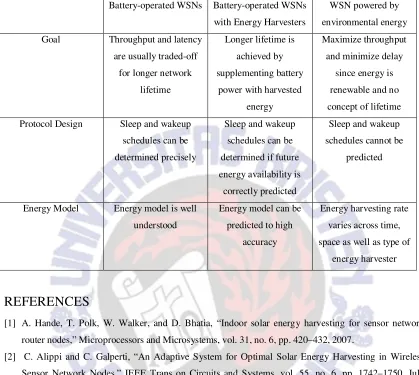45
A Survey on Wireless Sensor Networks Powered by
Environmental Energy
Daniel Santoso
Department of Electronic and Computer Engineering, Satya Wacana Christian University, Salatiga 50711, Indonesia,email:[email protected]
ABSTRACT
Sensor networks differ from traditional wireless networks in several respects. Unlike handheld wireless
devices which can be recharged at reasonable frequent intervals, sensor nodes must operate autonomously
for much longer durations. Energy supply thus remains an open challenge in sensor networks because
unfettered deployment rules out traditional wall socket supplies and batteries with acceptable form factor
and cost constraints do not yield the lifetimes desired by most applications. Wireless sensor networks
(WSNs) research has predominantly assumed the use of a portable and limited energy source, namely
batteries, to power sensors. Without energy, a sensor is essentially useless and cannot contribute to the
utility of the network as a whole. Consequently, substantial research efforts have been spent on designing
energy-efficient networking protocols to maximize the lifetime of WSNs. However, there are emerging
WSN applications where sensors are required to operate for much longer durations (like years or even
decades) after they are deployed. Examples include in-situ environmental/habitat monitoring and structural
health monitoring of critical infrastructures and buildings, where batteries are hard or nearly impossible to
replace/recharge. Lately, an alternative to powering WSNs is being actively studied, which is to convert the
ambient energy from the environment into electricity to power the sensor nodes. While renewable energy
technology is not new (e.g., solar and wind) the systems in use are far too large for WSNs. Those small
enough for use in wireless sensors are most likely able to provide only enough energy to power sensors
sporadically and not continuously. Sensor nodes need to exploit the sporadic availability of energy to
quickly sense and transmit the data. This paper surveys related research and discusses the challenges of
designing networking protocols for such WSNs powered by environmental energy.
46
portable and limited energy source, namely batteries, to power sensors and focused on extending the lifetime of the network by minimizing energy usage. Portable energy sources like batteries will experience current leakages that drain the resource even when they are not used; furthermore, any flaws in the packaging due to long term wear and tear can result in environmental problems.
A wireless sensor network that is not dependent on a limited power source (like a battery) essentially has infinite lifetime. Failure due to other causes (like structural hardware damage) can be overcome by self-organization and network re-configuration. This has motivated the search for an alternative source of energy to power WSNs especially for applications that require sensors to be installed for long durations (up to decades) or embedded in structures where battery replacement is impractical. In this paper, a brief survey of research on energy harvesting wireless sensor networks is provided at first. Then the ideal WSN that is powered solely by energy harvesting which is referred as WSN powered by environmental energy is defined. At the end, the challenges in designing networking protocols for such WSNs arising from the characteristics of the energy source is discussed.
II. RESEARCH ON ENERGY HARVESTING
47 There are complex tradeoffs to be considered when designing energy harvesting circuits for WSNs arising from the interaction of various factors like the characteristics of the energy sources, energy storage device(s) used, power management functionality of the nodes and protocols, and the applications’ requirements. Currently, the main sources of ambient energy considered suitable for use with WSNs are solar, mechanical (vibration or strain) and thermal energy. In the following subsections, research efforts in these areas are briefly presented.
A. Solar
Solar power is the most common and matured among the different forms of energy harvesting. However, it has the disadvantage of being able to generate energy only when there is sufficient sunlight or artifical light; furthermore, existing systems were not designed for use with low power WSNs, prompting new research efforts.
With the envisioned indoor WSN applications, a system has been developed to address the needs of WSNs deployed in indoor environments (e.g. hospital and industrial) where lights are operational at close to 100% duty cycle [1]. To ensure that energy is not unnecessarily lost during the transfer from the harvester to the wireless sensor, a low-power maximum low-power point tracker (MPPT) circuit [2] has been proposed to efficiently transfer the harvested solar energy to rechargeable batteries even in non-optimal weather conditions.
48
Figure 1. System architecture of WSN mote deployed indoor
The Heliomote [3], as shown in Figure 2, is a project focused on developing a plug-and-play solar energy harvesting module for use with Crossbow/Berkeley motes.
Figure 2. A Heliomote with its main components
Another effort conducted empirical and mathematical analysis of two micro-solar power systems and used the results to propose design guidelines for microsolar power systems for WSNs [4].
B. Mechanical
49 bridges, roads and rail tracks. One method of harvesting vibrational energy is through the use of a piezoelectric capacitor while kinetic energy can be harvested using a spring-loaded mechanism. Typical piezoelectric capacitors are shown in Figure 3.
Figure 3. Piezoelectric capacitors
In [5], a vibration-based harvesting micro power generator is used to scavenge environmental vibrations for use in a sensor node. Traffic sensors can also be solely powered by the short duration vibrations when a vehicle passes over the sensor [6]. Experimental results have shown that when a piezoelectric pushbutton is depressed, sufficient energy is harvested to transmit two complete 12-bit digital word information wirelessly [7]. Similarly, a system that harvests energy from the forces exerted on a shoe during walking has been demonstrated [8] and indoor locations, like staircases, are potential locations to harvest vibrational energy for powering wireless environmental sensors, as shown in [9].
C. Thermal
50
Figure 4. Thermogenerator with power management unit
To address the needs of telecommunications and other embedded applications, design of microstructured thermoelectric devices has been proposed in [11]. Due to the lack of moving parts in thermal energy harvesting devices, they tend to last longer than vibration-based devices.
D. Commercial Energy Harvesters
Energy harvesting devices are becoming available commercially. E.g., a Solar Energy Harvesting development kit, produced by Texas Instruments (http://www.ti.com), can be used to create perpetually powered wireless sensor networks based on their ultra-low power components. Advanced Cerametrics (http://www.advancedcerametrics.com) produces vibration-based energy harvesters that can replace batteries and be used to power wireless sensor nodes. Details on other commercially available energy harvesters for sensor nodes are available in [12].
III. RESEARCH IN ENERGY HARVESTING WSNs
While there has been extensive research on wireless sensor networks, those specific to energy harvesting WSNs are just emerging. With energy (or the lack of) being the key issue, it is unsurprising that the focus of research has been on power management.
A. Power Management
51 maximize the benefits of having the extra harvested energy. A consequence of using energy harvesting devices in sensor motes is that traditional metrics such as residual battery level is no longer usable in power management. Instead, information about future energy availability is required to make optimal routing decisions [13]. To achieve this, an environmental energy harvesting framework (EEHF) [14] has been proposed to adaptively learn the energy environment and make use of this information to more efficiently exploit the energy resources in order to improve the performance of the sensor network. Figure 5 presents the EEHF block diagram.
Figure 5. Interaction between various EEHF algorithms
A power management system, incorporating an analytical model for predicting various performance metrics, adaptive duty cycles and other related aspects, has also been developed [15]. Another approach assumes that sensors have two transmission modes that allow them to tradeoff energy consumption with packet error to maximize performance [16].
B. Data Delivery Schemes
52
Figure 6. Delivering data from a source across multiple wireless hops to the sink
Energy conservation has been and remains as the key objective in the design of networking protocols for WSNs. A recent survey on WSN protocols can be found in [17]. Many ultra-low power medium access control (MAC) protocols have been proposed for WSNs. However, any scheme that involves some form of backoff and retransmission is very likely to be non-optimal because timing schedules cannot be strictly enforced when a node has no energy to operate, and the amount of harvested energy may not be sufficient for retransmissions.
A polling-based MAC protocol has been proposed for use in sensors powered by ambient vibrations but the scheme has not been shown to be optimal [18]. Cooperative transmission protocols, an active area of research in wireless communications, have also been proposed for use in energy harvesting wireless sensor nodes [19].
53 In WSN powered by environmental energy, maximizing the network throughput is the main consideration since energy can be replenished. However, the amount of power provided by the environment is limited; therefore it is necessary to have a routing algorithm that takes into consideration actual environmental conditions [21]. The main idea is to model the network as a flow network and obtain the solution by solving the maxflow problem to maximize throughput. Another solution incorporates the energy replenishment rate into the cost metric when computing routes [22]. Geographic routing can also be modified to consider the amount of energy that can be harvested from the environment.
C. Topology and Connectivity
Power control is important to maintain connectivity through topology control. If the rate of harvested energy is not enough to power the sensor node continuously, this means that nodes have to go to sleep to charge up the battery, and this alters the network topology and therefore connectivity.
The performance of different sleep and wakeup strategies based on factors such as channel state, battery state and environmental conditions are analyzed in [23] and game theory is also applied to find the optimal parameters for a sleep and wakeup strategy to tradeoff between packet blocking and dropping probabilities [24].
Another study presented an analytical framework [25] to estimate various statistical properties of the system (e.g. expected downtime) given specific system parameters, such as, energy harvesting rate, buffer capacity, etc. It has also been shown that clustering in sensor networks can be improved by considering the characteristics of the energy harvesting process [26].
D. Energy Storage Technology
54
Figure 7. A wireless sensor node using supercapacitor as energy storage and solar cell as
energy harvester
A supercapacitor can be recharged for more than half a million-charge cycles and has a 10-year operational lifetime before the energy capacity is reduced to 80% [27]. The main difference between capacitors and supercapacitors lies in their energy storage density. Supercapacitors can store energy at higher energy density, and therefore its small form factor is more suitable for sensor nodes than using a capacitor.
E. State of Commercial Technology
55
(a) (b)
Figure 8(a). Integrated piezoelectric vibration energy harvester and wireless temperature
& humidity sensing node. (b). Integrated solar energy harvester and wireless strain
sensing node
IV. WSN POWERED BY ENVIRONMENTAL ENERGY NODE
CHARACTERISTICS
Using energy harvesting to supplement batteries does not eliminate the problem of having to replace the batteries when they run out. The process merely delays the inevitable. In applications like structural health monitoring of civil infrastructures, the sensors need to be installed in-situ (possibly embedded and out-of-reach after they are installed) and operate for long durations, from years to decades or even longer.
Combining low-power electronics, energy harvesting devices, and supercapacitors, it is possible to implement WSNs that rely solely on energy harvesting to operate. Although WSN powered by environmental energy is very promising for solving the energy constraints of traditional WSN, the power levels available from state-of-the-art energy harvesting devices is in the order of tens to thousands of µW or several mW (1% to 20% of operating power) which is not enough to power the sensor node continuously.
56
Technology Power Density [29]
(µW/cm2) Harvesting Rate
(mW)
Duty Cycle (%)
Vibration – electromagnetic 4.0 0.04 0.05
Vibration – piezoelectric 500 5 6
Vibration – electrostatic 3.8 0.038 0.05
Thermoelectric 60 0.6 0.72
Solar – direct sunlight 3700 37 45
Solar – indoor 3.2 0.032 0.04
Without the sustained energy supply, the exact sleep and wakeup timings are unknown. Therefore, the operating characteristics of WSN powered by environmental energy as compared to battery-operated WSN can be simply illustrated as shown in Figure 9.
57 In WSN powered by environmental energy, each sensor node is equipped with a small processor, a radio transceiver for communication, one or more energy harvesting devices, a capacitor / supercapacitor to store the harvested energy and a sensor. The key differentiating feature of a WSN powered by environmental energy node (as compared to a battery-operated WSN node) is the energy source which is a combination of energy harvesting device(s) and supercapacitor(s) instead of batteries. The sink is powered by an external source and remains on all the time.
V. DESIGN CHALLENGES
Instead of focusing on energy-efficient networking protocols to maximize the lifetime of sensor networks, the main objective is to maximize the information or data collected from the sensor network given the rate of energy that can be harvested from the environment. In the following subsections, the networking-related research issues are briefly discussed.
A. Topology Control
Topology control schemes can exploit transmission power control to increase the probability of successfully delivering the data to the next hop [30]. Larger transmission power means that more energy is required to be harvested before the node can receive or transmit data packets, thereby decreasing the duty cycles of the node. This may be necessary if a node’s neighbors have not harvested sufficient energy to operate. Therefore, transmission power control is crucial in optimizing the performance of WSN powered by environmental energy. This also influences the logical topology and deployment strategies [31].
B. Medium Access Control (MAC)
58
harvesting periods thereby reducing throughput.
C. Routing
Since the wakeup time of any sensor cannot be estimated accurately because the exact rate of energy harvested fluctuates with time and other environmental factors, it is very difficult to ensure that the next-hop node is awake to receive a packet. The uncertainty in how long it takes a node to harvest enough energy before it can function again makes existing sleep-wake scheduling schemes for WSNs unusable since a node may not have harvested sufficient energy at the scheduled wakeup time.
Furthermore, if it has depleted all its energy in its previous cycle, it may loose its timing reference when it wakes up again. Therefore, broadcast and opportunistic schemes are more suitable in WSN powered by environmental energy. However, broadcasting may result in many duplicates if many nodes are awake; therefore, some form of duplication-suppression is needed so that the harvested energy is not wasted on delivering duplicates.
59
D. Reliable Data Delivery
Reliable data delivery may be required for some applications. Since the source node is not awake all the time, it is a challenge to design reliable transport protocols, as many reliable transport protocols need to make use of positive feedback for retransmissions. Another requirement to ensure each flow gets its fair share of bandwidth given the amount of energy that can be harvested from the environment.
Since energy is free because it is renewable, nodes further away from the sink may starve the nodes nearer the sink if forwarding packets have higher priority than the node’s own packets. Therefore, there is a need for a transport protocol to regulate the data flow such that any source will get its fair share of bandwidth no matter where it is located in the network.
VI. CONCLUSION
Wireless sensor networks that are powered by ambient energy harvesting is a promising technology for many sensing applications as it eliminates the need to replace batteries. However, the current state of technology in energy harvesting is still unable to provide a sustained energy supply to enable WSNs continuously.
60
router nodes,” Microprocessors and Microsystems, vol. 31, no. 6, pp. 420–432, 2007.
[2] C. Alippi and C. Galperti, “An Adaptive System for Optimal Solar Energy Harvesting in Wireless
Sensor Network Nodes,” IEEE Trans on Circuits and Systems, vol. 55, no. 6, pp. 1742–1750, July
2008.
[3] K. Lin et al., “Heliomote: Enabling Long-Lived Sensor Networks Through Solar Energy Harvesting,”
in Proc. of the ACM SenSys, San Diego, CA, USA, November 2-4 2005.
[4] J. Jeong, X. Jiang, and D. Culler, “Design and analysis of micro-solar power systems for wireless
sensor networks,” in Proc. of the 5th Intl Conference on Networked Sensing Systems (INSS),
Kanazawa, Japan, June 17-19 2008, pp. 181–188.
[5] Y. Ammar, A. Buhrig, M. Marzencki, B. Charlot, S. Basrour, K. Matou, and M. Renaudin, “Wireless
sensor network node with asynchronous architecture and vibration harvesting micro power generator,”
in Proc. of Joint sOc-EUSAI conference, Grenoble, France, October 12–14 2005, pp. 287–292.
[6] K. Vijayaraghavan and R. Rajamani, “Active Control based Energy Harvesting for Battery-less
Wireless Traffic Sensors: Theory and Experiments,” in Proc. of American Control Conference, NY,
61 [7] Y. K. Tan, K. Y. Hoe, and S. K. Panda, “Energy Harvesting using Piezoelectric Igniter for
Self-Powered Radio Frequency (RF) Wireless Sensors,” in Proc. of IEEE Intl Conference on Industrial
Technology (ICIT), Mumbai, India, December 15-17 2006, pp. 1711–1716.
[8] J. A. Paradiso, “Systems for Human-Powered Mobile Computing,” in Proc. of the 43rd Design
Automation Conference (DAC), San Francisco, CA, USA, July 24-28 2006, pp. 645–650.
[9] E. S. Leland, E. M. Lai, and P. K. Wright, “A Self-Powered Wireless Sensor for Indoor
Environmental Monitoring,” in Proc. of the Wireless Networking Symposium (WNCG), Austin, TX,
USA, October 20-22 2004.
[10] L. Mateu, C. Codrea, N. Lucas, M. Pollak, and P. Spies, “Energy harvesting for wireless
communication systems using thermogenerators,” in Proc. of the XXI Conference on Design of
Circuits and Integrated Systems (DCIS), Barcelona, Spain, November 22–24 2006.
[11] H. B¨ottner et al., “New Thermoelectric Components Using Microsystem Technologies,” Journal of
Microelectromechanical Systems, vol. 13, no. 3, pp. 414–420, June 2004.
[12] M. T. Penella and M. Gasulla, “A review of commercial energy harvesters for autonomous sensors,”
in Proc. of Instrumentation and Measurement Technology Conference (IMTC), Warsaw, Poland, May
1- 3 2007, pp. 1–5.
[13] V. Raghunathan, A. Kansal, J. Hsu, J. Friedman, and M. Srivastava, “Design considerations for solar
energy harvesting wireless embedded systems,” in Proc. of Information Processing in Sensor Networks
(IPSN), Los Angeles, CA, USA, April 25-27 2005, pp. 457–462.
[14] A. Kansal and M. B. Srivastava, “An Environmental Energy Harvesting Framework for Sensor
Networks,” in Proc. of the Intl Symposium on Low Power Electronics and Design (ISLPED), Seoul,
Korea, August 25-27 2003, pp. 481–486.
[15] A. Kansal, J. Hsu, S. Zahedi, and M. B. Srivastava, “Power Management in Energy Harvesting Sensor
Networks,” ACM Trans on Embedded Computing Systems, vol. 6, no. 4, September 2007.
[16] A. Seyedi and B. Sikdar, “Energy Efficient Transmission Strategies for Body Sensor Networks with
Energy Harvesting,” in Proc. of the 42nd Annual Conference on Information Sciences and Systems
(CISS), Princeton, NJ, USA, March 19-21 2008, pp. 704–709.
[17] J. Yick, B. Mukherjee, and D. Ghosal, “Wireless sensor network survey,” Computer Networks, vol. 52,
no. 12, pp. 2292–2330, August 2008. [18] W.-J. Wu, Y.-F. Chen, Y.-Y. Chen, C.-S. Wang, and Y.-H.
Chen, “Smart Wireless Sensor Network Powered by Random Ambient Vibrations,” in Proc. of IEEE
Intl Conference on Systems, Man, and Cybernetics (SMC2006), Taipei, Taiwan, Oct 8-11 2006, pp.
2701–2708.
[19] M. Tacca, P. Monti, and A. Fumagalli, “Cooperative and Reliable ARQ Protocols for Energy
Harvesting Wireless Sensor Nodes,” IEEE Trans on Wireless Communications, vol. 6, no. 7, pp.
62
Wireless Networks with Renewable Energy Sources,” IEEE/ACM Trans on Networking, vol. 15, no. 5,
pp. 1021– 1034, October 2007.
[23] D. Niyato, E. Hossain, and A. Fallahi, “Sleep and Wakeup Strategies in Solar-Powered Wireless
Sensor/Mesh Networks: Performance Analysis and Optimization,” IEEE Trans on Mobile Computing,
vol. 6, no. 2, pp. 221–236, February 2007.
[24] D. Niyato, E. Hossain, M. M. Rashid, and V. K. Bhargava, “Wireless Sensor Networks with Energy
Harvesting Technologies: A Game- Theoretic Approach to Optimal Energy Management,” IEEE
Wireless Communications, vol. 14, no. 4, pp. 90–96, August 2007.
[25] A. E. Susu, A. Acquaviva, D. Atienza, and G. D. Micheli, “Stochastic Modeling and Analysis for
Environmentally Powered Wireless Sensor Nodes,” in Proc. of the IEEE Intl Symposium on Modeling
and Optimization in Mobile, Ad Hoc, and Wireless Networks(WiOpt), Berlin, Germany, March 31 -
April 4 2008, pp. 11–20.
[26] T. Voigt, A. Dunkels, J. Alonso, H. Ritter, and J. Schiller, “Solaraware Clustering in Wireless Sensor
Networks,” in Proc. of IEEE Intl Symposium on Computers and Communications (ISCC), Alexandria,
Egypt, Jun 28 - Jul 1 2004, pp. 238–243.
[27] F. I. Simjee and P. H. Chou, “Efficient Charging of Supercapacitors for Extended Lifetime of
Wireless Sensor Nodes,” IEEE Trans on Power Electronics, vol. 23, no. 3, pp. 1526–1536, May 2008.
[28] S. W. Arms, C. P. Townsend, D. L. Churchill, J. H. Galbreath, and S. W. Mundell, “Power
Management for Energy Harvesting Wireless Sensors,” in Proc. of SPIE Intl Symposium on Smart
Structures and Smart Materials, San Diego, CA, USA, March 2005, pp. 267–275.
[29] B. H. Calhoun, D. C. Daly, N. Verma, D. F. Finchelstein, D. D. Wentzloff, A. Wang, S. H. Cho, and
A. P. Chandrakasan, “Design Considerations for Ultra-Low Energy Wireless Microsensor Nodes,”
IEEE Trans on Computers, vol. 54, no. 6, pp. 727–740, June 2005.
[30] H. P. Tan, Z. A. Eu, and W. K. Seah, “Impact of Power Control in Wireless Sensor Networks Powered
by Ambient Energy Harvesting for Railroad Health Monitoring,” in Proc. of the 2nd Intl Workshop on
Applications of Ad hoc and Sensor Networks (AASNET), Bradford, UK, May 26-29 2009.
[31] Z. A. Eu, H. P. Tan, and W. K. G. Seah, “Routing and relay node placement in wireless sensor
networks powered by ambient energy harvesting,” in Proc. of the IEEE Wireless Communications &
63 [32] Z. A. Eu, W. K. G. Seah, and H. P. Tan, “A Study of MAC Schemes for Wireless Sensor Networks
Powered by Ambient Energy Harvesting,” in Proc. of the Fourth Intl Wireless Internet Conference



